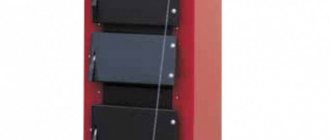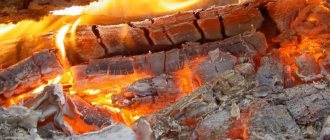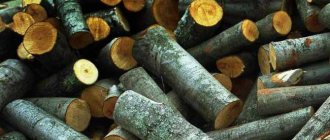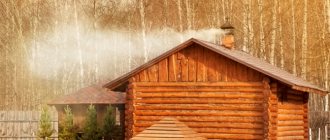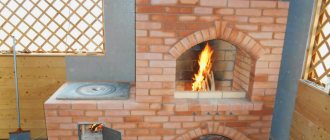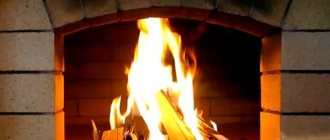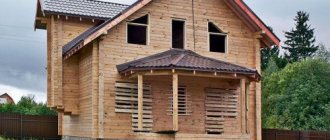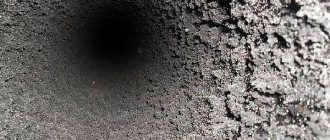What is the best way to heat a bathhouse?
Oak firewood
The oak must be middle aged. Young oak does not provide the necessary heat, and fills the bathhouse with the smell of charcoal. An old oak tree contains a lot of decayed wood, which produces more ash than heat. The air in a bathhouse heated with old oak will be heavy. Good firewood fills the bathhouse with heat and the aroma of forest and freshness.
Birch firewood
The most common firewood is birch. They light up easily and burn with a long, even flame. The heat from the stove heated with birch wood disinfects the bathhouse, filling it with a light fragrant aroma. However, birch firewood becomes less fragrant after two years of storage. In addition, if the air dosage in the stove is incorrect, when the wood burns smoky, tar and birch resin are sublimated along with the smoke. It settles quite abundantly on the walls of the pipe, and sometimes flows down if the pipe is thin-walled and cools easily. The abundance of tar on the pipe walls is a fire hazard.
Linden firewood
Since ancient times, linden firewood has been used in special cases. For warriors who were wounded in battles with enemies, hot baths were heated with linden wood, and they were given a decoction of linden blossom with linden honey. Linden spirit in the bath is healing for the skin and respiratory system. Linden is quite difficult to light, it flares up slowly, but its fire is long and persistent. Linden firewood should not be stored for more than two years.
Alder firewood
In Russia, alder firewood is considered royal firewood. Along the end and the chip, they turn reddish in air and are sharply different from other logs. Alder wood burns hot and produces almost no smoke. For firewood, it is better to choose alder on soils with the least moisture. A sauna heated with alder wood has an anti-cold effect. Alder firewood dries quickly enough and retains its unique smell for a long time. Even after three years, alder firewood retains its specific aroma.
Aspen firewood
In the villages they say: aspen does not burn without kerosene. This is because aspen wood is quite difficult to light. If aspen is placed in an already heated stove, it burns quite hot and holds the heat for a long time. In villages they also believe that aspen wood, when burned, cleans the chimney. Aspen firewood is usually cheaper than others. As a rule, aspen is a clumsy tree and is not fully used; there is a lot of waste, which is used for firewood.
Coniferous firewood
The most common firewood is softwood, spruce and pine. Pine, due to its higher resin content, burns hotter than spruce. It should be remembered that in resinous wood, when burning, a sharp increase in temperature, the resin sinuses burst, small cavities in the wood where resin accumulates. and this causes a characteristic crackling sound and sparks fly in all directions. Including through the open oven door. When you add firewood or mix it with a poker, it is better to wear glasses to protect your eyes. And when the stove door is closed, look carefully at the floor near the stove to see if a spark has flown somewhere. It is better to prevent a fire than to put it out.
Coal
Often, instead of firewood, coal is used for kindling, which has both advantages and some disadvantages. First of all, the use of coal is more profitable, since it requires less wood to heat a bathhouse than firewood, and in addition, the heat from burnt coal remains for quite a long time. The disadvantages include the increased humidity that appears during combustion, as well as the lack of aroma that burning wood gives.
In no case should you use old things, garbage, etc. for the firebox, as many materials are toxic and can harm those steaming.
It is known that 1 kilogram of dry firewood provides 2800 kcal. To get these calories when burning different types of wood, you need to take the appropriate amount (in kilograms) of firewood, depending on its volumetric weight. Volumetric weight of firewood in kg/cubic meter. to get 2800 kcal:
Features of pine firewood and its correct use
But the fireplace is open, and the stoves are tightly closed with doors. Therefore, for stoves this problem is not as serious as the soot that forms inside the chimney in large quantities due to the high tar content. There are ways to solve such a problem. They are the same as in the case of birch. You just need to heat the stove not with pine alone, but in combination with other species that do not contain resin and do not form a large amount of soot and soot.
Pine firewood must be used together with aspen, firewood from fruit and berry trees. Also, every time you heat the stove, use potato peelings along with firewood. Starch softens carbon deposits, making them easier to clean later. When using coniferous wood, including pine, the chimney will have to be cleaned more often.
In addition, it is important to more carefully follow fire safety rules, ensure that the oven door closes tightly, and that the floor and all surfaces of the room in which the oven is located are made of fire-resistant materials. If these rules are not followed, then it is better to refuse to use pine firewood. If you follow all the rules, you can use pine wood to heat your stove , as it is a fairly efficient and inexpensive fuel.
Did you like the article? Subscribe to the channel to stay up to date with the most interesting materials
Source
Answers from experts
It's Ost Ukraine:
Better. Poplar smolders more, pine gives off little heat. Maple is somewhere next to aspen, after acacia and oak. Since this question came up, I’ll add it too))) The most heat-giving ones are acacia. Even raw ones flare up in no time))
Walking by Myself:
poplar is very energy-intensive, I can’t tell you about the others
Olga Meshkova:
Pine logs burn hotter and longer than maple ones due to the resin in them. Birch firewood is also good - it burns hot. Maple is like a flame. Poplar is just soft wood and that’s it. It's easier to prick. If you choose firewood, then pine and birch. Pine splits more difficult than birch.
Irina Ivina:
In our area, the most valuable firewood is pine and birch (hot) and add a little aspen (cleans the chimney of soot). The Christmas tree is valued lower and is less prickly. Poplar and maple are not considered firewood
Roman Shved:
In short, buddy!!! My advice to you: delete the previous answers. The worst firewood: spruce, pine, poplar. They burn quickly, but are of no use. One headache. Common firewood: birch, alder, aspen. Firewood for “millionaires” is maple, ash, oak, hornbeam, beech, and rowan. For “millionaire” gourmets, all the firewood is from fruit trees. And if you have maple ridges more than 1 meter long... I envy you. Feel free to sell them to a furniture factory or private carpenters... they will kiss your ass and bring you 10 cubic meters of production waste for free to fire the stove.
Maxim Paromoshin:
As far as I know: alder was considered “royal firewood”, with a lot of heat and little soot. Poplar - don't take it. There is not enough heat (in my experience). Empty tree. Birch is the most popular and good firewood. Aspen - if available - is good for cleaning a chimney.
Lone Wolf (EW1AAD):
Easily! The calorie content is not very high - but you can burn it - the chimney will not become clogged with soot)
Andrey Kostenko:
Anything is good for firewood, but if you have to choose, birch is the best heating product, and poplar is empty shit.
Goon Goon:
But I live in the city and I don’t know.
AUH:
It's good, but it stinks when sawing
Metin Çiftci:
vice versa! The chimney will have to be cleaned more often! poplar burns quickly, warms, but the heat quickly evaporates!
Maksvel-haus:
Everything is burning in the stove, but the warmth comes from the birch and fir trees.
Kotofey:
It's a pain to inject, it burns out quickly and the heat transfer is low
Valya Tyutchenko:
I live in Kuzbass in a small town, this is the second year we have been exterminating poplars and selling them to the population for firewood. They are quite suitable for lighting coal. But I don’t think so much as an independent fuel. You didn’t write that you want to heat a bathhouse, a fireplace, or a stove in the house for heating.?
Daria Vikhrova:
We are engaged in cutting down city poplars, people often ask, we give them away for free
Semyon Altakh:
I picked up a felled poplar, chopped it, flooded it, and how it fucked me up. It doesn’t burn if you don’t burn anything except the poplar; it doesn’t burn at all, but it’s a little damp for me. What I like about poplar when it burns is its wonderful smell, I absolutely love it and the fact that it’s free
Oksana Bobinskaya:
It burns well together with birch. Creates a wonderful smell inside the bathhouse. There is almost no waste.
Optimal options
Alder firewood. Alder logs are considered the best, optimal firewood for use in a bathhouse. In ancient times, the baths of the nobility and kings were heated with alder. It is believed that the best firewood is obtained from alder, which grew in dry soil, away from rivers and lakes. The wood of such trees is porous, light, it dries easily and is stored for a long time without losing its basic properties. When lighting such wood, the fire quickly catches on.
A distinctive feature of alder firewood is the absence of smoke, while it produces a lot of heat. The fact is that alder wood contains practically no resinous substances.
Alder firewood can be safely used in a black sauna without fear of getting burned from the smoke. When burned, the wood of this type of tree releases a pleasant aroma, so alder sawdust is actively used when smoking meat and fish. The wood burns steadily, calmly, without sparks or crackles. The cost of alder firewood is quite reasonable, and wood is almost always available from trading organizations.
Oak firewood. Oak firewood is one of the strongest in terms of heat transfer, surpassed only by ash and hornbeam logs. It is believed that it is optimal to harvest oak in its prime, since there is not much heat from young trees, and when old wood burns, a lot of ash is formed.
When burned, oak wood emits a characteristic forest aroma that many people enjoy. That is why oak firewood is actively used in open fireplaces and black saunas. In addition, according to doctors, the warmth and aroma of burning oak has healing properties, having a beneficial effect on the respiratory system.
Birch firewood. Birch firewood is considered optimal in terms of price and quality. Birch is not a rare tree, so it is harvested on an industrial scale. Birch wood burns easily and produces a stable and good heat. Fire catches well on birch, so you can light a stove even with wet wood.
For a bathhouse, birch firewood is simply a godsend, because along with good heat transfer, the steam from it has healing and disinfecting properties. A birch wood bath is recommended for colds and chronic respiratory problems. You can use birch, oak and alder in both white and black baths, the main thing is to tear off the bark, the resin content of which is much higher.
Birch logs can be stored for several years without losing their properties. The cost of birch forest is reasonable; in principle, everyone can afford it.
Ash firewood. Ash has the strongest heat transfer among other trees. Firewood made from it is expensive and scarce; it is not so easy to find. The high heat transfer of ash is due to the extreme density of its wood. This type of wood burns even when wet. For a bath this option is very good.
Firewood from linden. Linden firewood can be used to light a bathhouse, but it’s worth noting right away that they don’t produce much heat. At the same time, linden logs burn quickly enough, creating an even fire, you only have time to toss them.
The aroma emitted by linden when burned is considered healing, having a good effect on people with respiratory diseases. Linden retains these healing properties during two years of storage, and after that the quality of the wood deteriorates sharply. Linden is not harvested for future use; it is used in the off-season for preventive purposes, as well as to treat colds and relieve stress.
Instructions on how to properly heat a sauna
- The hardest part is kindling. First of all, open the valve in the pipe, otherwise carbon monoxide will not escape. Be sure to check that this condition is met before each kindling.
- Chop some wood and prepare 4 logs. In addition, you will need newsprint.
- Place 6-7 crumpled sheets of paper in the oven. Place wood chips on them, and mark 4 logs on top, preferably perfectly dry ones. Moreover, it is advisable to distribute the logs across the entire width of the stove, rather than stack them on top of each other.
- Light the paper under each of the logs and quickly close the firebox, otherwise you will release smoke. Don't be afraid, 95% of the time the fire will flare up, so you don't have to watch it with the firebox open.
- After 15 minutes, add more firewood. How often to add them in the future depends on their dryness, but in the first hour of the fire, the main thing is not to miss the moment - to add them when the old firewood, which has turned into coals, begins to break into several parts. After about 1.5-2 hours, the temperature in the firebox will rise significantly, and it will be possible to add fuel even when there are only coals left in the stove.
- Place new firewood as close to the door and as far from the chimney as possible. This way you will increase the area of contact between the fire and the pipe, thereby reducing the time it takes to heat the bathhouse.
- If there is good draft (this is evidenced by bright red, as if swollen, coals in the firebox), after 2 hours you can close the valve halfway. This will also reduce the time you spend heating the sauna and save fuel.
- It is better to steam brooms directly in the steam room, when it has reached at least 60°C.
- Do not start heating the sauna if there are wooden containers in the steam room (for example, a bucket from which you throw it) that are not filled with water. This will lead to their rapid drying out.
- If the sauna is new, heats well, and you are happy with the temperature, then you can start steaming. The valve can only be closed when all the carbon monoxide has left the firebox. If, after stirring the coals in the firebox, you see a bluish-greenish flame appear, then carbon monoxide is still present. In a bathhouse that is difficult to light and quickly loses temperature, it is necessary to remove all the coals from the firebox and completely close the valve.
In order for the bathhouse to always smell good and have good heat, you need to take care of the quality of the firewood. Bad firewood can cause unpleasant odors, such as mold or swamp, to appear in the sauna, and, in addition, much more firewood than usual may be needed to heat the steam room.
The best firewood for a sauna based on wood density
First of all, it is worth noting that they are:
- Solid (with high calorific value and long-lasting heat in the combustion chamber - oak, ash, hornbeam, maple);
- Medium-hard (with less heat release - cherry, apple, pear, alder, birch, larch, pine);
- Soft (with a minimum percentage of room heating due to rapid combustion - aspen, alder, willow).
Of course, firewood from the first group is preferable for a bathhouse, since it is dense, finely porous, producing coals that do not go out for a long time and a sufficient level of heat.
The next type is loose trees with low density. They maintain a bright flame, but go out very quickly, with virtually no time to give off heat.
Selection options
When choosing firewood, it is important to consider the following characteristics of wood:
Ease of preparation . When preparing firewood yourself, it is important to consider how it is sawed and split. For example, white acacia has a high heat output, which makes it attractive as a fuel. However, the structure of this wood is dense, viscous, and has many interwoven fibers. Therefore, splitting acacia firewood yourself turns into a real test of strength. Oak can be contrasted with the unruly acacia. Despite its high strength, it can easily be split with a regular ax or a special cleaver.
Ash content . The more minerals a tree contains, the more ash it leaves. Ash content is measured as a percentage of the total weight of firewood. It is divided into internal (in an amount from 0.2 to 2.16%) that is present in the tree under natural conditions, and external (up to 20%), introduced during harvesting, storage or transportation. Moreover, the second significantly exceeds the first. The ashiest types of firewood are pine - 2.19 - 1.39%; spruce – 2.23 – 2.31%; birch – 2.43 – 0.52%; aspen – 2.73%.
Region where the bathhouse is located . This is one of the important factors in economic terms. For example, hornbeam has the highest calorific value. But if the bathhouse is built in a place where this tree does not grow, then a lot of money will be spent on purchasing firewood. Therefore, to fire a stove in a bathhouse, you should choose wood with the highest heat transfer value among that which is common in the region where the bathhouse is located.
Storage features . If firewood is being prepared for future use, you need to pay attention to how suitable the variety will be for long-term storage. The least susceptible to rotting are oak, alder, ash logs and larch. Willow, linden, poplar or aspen must be used up first, or provided with ideal conditions.
Important component 3 - the correct combustion algorithm
We place two logs parallel to each other on the grate at a distance of 10-15 cm. Between them is a crumpled sheet of paper, which we cover with wood chips or shavings. The “seed” is completed by two more logs laid diagonally on top.
We set fire to the “seed”
Using a match or kitchen lighter, light the wad of paper in the “seed”. You cannot use flammable liquids to speed up ignition: gasoline, diesel fuel, kerosene, xylene, acetone, etc. If the firewood is damp and cannot be ignited, you can use a dry alcohol tablet. We wait for the characteristic flame noise to appear in the stove, close the firebox door and cover the vent (not completely).
Throwing wood into the stove
The “seed”, of course, will not be enough to light the stove. Therefore, to continue combustion, you will have to add firewood from time to time. The first time this is done 10-15 minutes after igniting the “seed”. We open the firebox door, level with a poker everything that remains of the “seed” and place the firewood in approximately 2/3 of the volume of the stove firebox.
In the future, a new portion of firewood is laid when the old one burns out - approximately once every 1-1.5 hours.
We complete the heating of the bathhouse
In winter, the sauna is heated for at least 5-6 hours, in summer it is faster - on average 3-4 hours. When the bath has heated to the required temperature, the firebox can be finished. We wait for the last portion of firewood to burn out, open the firebox door and check for bluish flames above the coals - signs of the presence of carbon monoxide. If everything is in order, close the vent, smoke valve and firebox completely.
After everything has been done, we open the doors of the steam room and the window so that the bathhouse can be ventilated. 15 minutes is enough for the bathhouse to be filled with fresh air. After that, close everything except the window. The bath should last for about two hours. Don’t be afraid, during this time it will not have time to cool, but the heat will become soft, uniform, and the steam will become light. Afterwards we close the window and begin the bath procedures.
There are three answers to this question: from a practical, health-improving and economically beneficial point of view.
- The first insists that hard types of wood should be used for a bathhouse, since they burn longer and produce more heat.
- The second states: it is preferable to take “healing” logs that have the most positive effect on the body.
- The third speaks about the advisability of using only firewood for heating that is obtained directly on site and, therefore, is inexpensive.
Important component 2 - oven preparation
Now that the firewood has been selected, you can think about lighting the sauna stove. First you need to prepare it - we will melt it later. We follow the instructions:
- We clean the grate and ash chamber (ash pan) from ash and coals;
- Wash stones in clean water;
- We determine whether there is draft (chimney permeability) necessary for carbon monoxide to escape from the stove.
To do this, open the smoke valve in the chimney, the firebox and ash doors. Then we bring a lit match into the firebox and watch where the flame rushes. If it goes up, that is, it is drawn into the chimney, then everything is in order - there is draft. You can start kindling. Otherwise, you will have to first clean the chimney, since it is prohibited to heat the bathhouse without draft - the stove will “smoke”.
Step-by-step instructions for properly heating a sauna
As we already wrote above, firewood for a bath must be dry and of high quality, and this directly depends on its proper storage.
If you prepare your own logs for kindling, then they need a dry and protected place, such as.
Wash the stones, make sure there is enough clean cold water for washing. Open the valve on the pipe through which harmful carbon monoxide will escape. Prepare wood chips for kindling and 4 logs. Place them on the stove grate, spreading them across its entire width. Then stick a few crumpled up sheets of paper or newspaper into the oven. Light them and close the firebox door. After 15 minutes, you can throw in a couple more logs. How often you will have to add firewood during the first 1.5–2 hours of kindling depends on how dry it is and how quickly it burns out. The main thing here is not to miss the moment when the burnt tree, which has become coals, begins to split - then you need to throw the next portion of logs. When the temperature in the firebox becomes high enough, firewood can be added less frequently, even after there are only coals in the stove. In order for the fire to burn better and the time to kindle the bathhouse to be shorter, new firewood should be placed closer to the stove door and away from its chimney. If the draft is strong enough, and this can be seen by the presence of red swollen coals in the firebox, after 2 hours the valve can be closed halfway
This will not only save fuel, but will also speed up the process of warming up the bath. It is important to periodically stir the coals with a poker, but try not to touch the hot firebox door to avoid getting burned. Laying a new portion of firewood must be repeated several times. In summer, the sauna is heated for about three hours in a row, and in winter for at least 5 hours
In this case, it is necessary to control the water level in the boiler, add it in time, not allowing it to completely evaporate. After you feel that the bathhouse has warmed up well, you need to thoroughly ventilate it again, opening all the windows and doors. If you have
The firebox is a whole ritual. Let's take a closer look at all the subtleties of bath art.
Before stacking firewood in the firebox, the grate and ash chamber are cleaned of residual combustion products in order to completely free access of air to the burning fuel, otherwise a stove with a ash pit will turn into a stove with a blind hearth, which is uneconomical. Increased humidity in wood impairs combustion, so they must be dried beforehand.
It is necessary to stack firewood with gaps and in such a way that there is at least 200 mm left to the top of the firebox. It is advisable to heat the bathhouse with dry birch wood, which produces less soot, or aspen, pine, oak, spruce, etc.
You cannot throw painted wood, plastic, roofing felt, or bitumen into the firebox. Do not overheat the stove: cracks will appear in the lining and masonry. When there is no bluish-blue flame above the remaining coals in the firebox (a consequence of the combustion of poisonous carbon monoxide, the so-called carbon monoxide), the firebox is considered complete. After 5-10 minutes, you can tightly close all doors and dampers.
To avoid carbon monoxide poisoning, do not light the stove late in the evening. If the design provides for the stove to operate on coal or anthracite, the valve should be installed in such a way that it does not close tightly and leaves a gap of at least 10-15 mm.
First, light the stove with small wood. A 50-60 mm layer of coal is poured onto them. After the coal burns well, the backfill thickness is adjusted to 150 mm, but no more, otherwise fuel consumption will be uneconomical. After the fire is completed, the remaining coals are raked onto the grate so that they are well blown with air coming from the ash pit.
If there is no grate, rake it closer to the outlet of the oven. If there is excessive gas formation in the firebox, a flame may erupt. This usually happens when they try to light the stove with flammable liquids (gasoline, kerosene, etc.). If the concentration of gases is high, an explosion may occur, which can not only destroy the furnace, but also cause a fire.
The firebox cannot be loaded with a new portion of fuel (especially fine-grained fuel), completely covering the hot surface of the furnace bottom: it “languishes,” releasing a large amount of volatile substances, without flaring up due to the lack of flame and a decrease in temperature. In this case, the concentration of gases increases sharply and at the first appearance of a flame an explosion occurs.
Therefore, fine fuel must be loaded into the furnace in small portions, giving it the opportunity to flare up gradually
The fire door must be opened carefully so as not to cause a sudden fire.
The best firewood for a bath in terms of savings
Hornbeam, maple, ash, and oak are incredibly expensive, so the population makes a practical choice in favor of those trees that grow en masse in their region. Birch and aspen are especially often chosen - they are healing, provide enough heat, and do not clog the chimney too much with soot.
But the most important requirement is dryness. The wood must rest so that the percentage of water in it does not exceed 15-20 units. It is this type of firewood that burns hot, melts easily and emits a fragrant odor. The right time to harvest logs for a bathhouse is winter, in particular January and February, when the wood is frozen and there is a minimum of moisture in it.
The main indicator for firewood is its degree of thermal conductivity. When choosing firewood for a bathhouse, this factor must be taken into account. More experienced bathhouse attendants endow them with special mystical powers, carefully sharing recipes for kindling and maintaining the fire.
Time moves inexorably and modern technologies and scientific knowledge come to the aid of lovers of good steam. Thanks to this, it is possible to achieve the desired result at lower costs.
General points
It often seems to the average person that there is plenty of firewood for a bathhouse, but this is not entirely true. For example, old wood, rotten boards and stumps are not the most suitable option for lighting a stove in a bathhouse, despite the fact that no preparations can match the efficiency of such wood. This wood provides practically no heat transfer, it smokes and smokes, and besides, the space of the bathhouse is gradually filled with the unpleasant smell of burning mold. As a result, using rotten wood will not allow you to spend time normally in warmth and comfort, but will only complicate the whole process.
It is not without reason that they say that properly heating a bathhouse is a whole art, which was valued by our ancestors, and the aura of mysticism only added to the authority of professional bathhouse attendants. Nowadays, when everyone has access to information, you can quickly analyze the most popular types of firewood and choose the most suitable option for yourself in terms of price and quality.
The main feature of good wood is its density. Firewood from trees with a dense structure burns better and produces more heat. Since heat is one of the main indicators for a bathhouse, the easiest way is to consider the quality of firewood by its heat transfer, and only then by other parameters: smoke emitted, smell, rate of combustion of logs in the stove. Let's look at the most suitable firewood for a bath from different types of trees.
Important component 1 - good firewood
The choice of firewood determines how quickly your sauna will be heated and how hot the sauna will be. Preference should be given to hardwood: hornbeam, oak, ash, maple. These rocks have the highest heat transfer, that is, they release the greatest amount of heat during combustion. The calorific value of wood from fruit trees (apple, pear, cherry) is somewhat lower, but it also provides good heat in the oven. The calorific value of deciduous trees is even lower: birch, alder, etc. Despite this, deciduous trees are used most often due to their availability and low cost. Coniferous firewood is the least popular choice for heating a sauna stove. This wood produces little heat; in addition, when burned, it produces a lot of soot, which settles in the chimney and on stones.
Another important characteristic of firewood that is also worth paying attention to is humidity. The smaller it is, the better the sauna will be heated. Ideally, the moisture content of the wood does not exceed 20%
Freshly cut wood has a moisture content of 33 to 50%, so it burns poorly. To dry such firewood, it is enough to let it rest for some time in a dry, well-ventilated room.
Ideally, the moisture content of the firewood does not exceed 20%. Freshly cut wood has a moisture content of 33 to 50%, so it burns poorly. To dry such firewood, it is enough to let it sit for some time in a dry, well-ventilated room.
Now let’s figure out what kind of wood it is better not to heat the bathhouse with. Not suitable for this:
- old boards and logs - due to the unpleasant smell when burning.
- Rotten firewood burns poorly and produces a lot of ash.
- Wood impregnated with chemical compounds releases substances hazardous to health during combustion.
Logs from fruit trees
Fruit trees also have good properties needed for a hearth. They are used both for stoves and for barbecues and smokehouses. Fruit wood has a very good aroma.
When cutting down fruit trees, it is advisable to store this wood and then use it to light the stove. It will also be used for barbecue and smokehouse. Most often, this wood can be purchased by cutting down old orchards. The most common trees for kindling are cherry or apple. Cherry logs emit more soot, but light up very well. Apple logs do not produce much smoke, therefore they are considered the highest quality fuel.
Medicinal properties are attributed to many fruit trees, for example, apple and pear trees of certain ages.
What kind of wood is best to heat a bathhouse?
Surely, you ask, what is the best way to heat a bathhouse? In Russia, birch wood is most often used to light the stove. They flare up very quickly and give an even and stable heat.
Firewood from other trees or coal can also be used to light a bathhouse, but their usefulness and calorie content when burned is much lower than that of the Russian beauty birch. For example, firewood made from oak or ash is quite expensive. Poplar and aspen have low heat transfer. Spruce and pine, although they smell very pleasant, can smoke heavily when kindled. When burned, coal emits toxic smoke. And only alder can compete with birch in terms of the quality of kindling in a sauna stove, but the aroma from its firewood will still not be so wonderful and pleasant.
Benefits of wood fuel
Why do many people choose to light the stove with wood if this process is quite labor-intensive? Many people know firsthand that this is the most environmentally friendly and healing way to create heat in a steam room.
Professional bath attendants also note other advantages of this type of fuel, because firewood:
- do not explode, thereby providing gradual and safe heating of the room;
- are relatively inexpensive;
- burn for a long time;
- give off a lot of heat.
Photo from the site https://tourizm74.ru
An alternative to logs can be wood processing products called pellets. They are granules of compressed sawdust. This material is easy to transport, but when using sawdust for a bath procedure, it is quickly consumed.
If you still prefer wood, then it will be useful for you to know which species to choose for the firebox.
